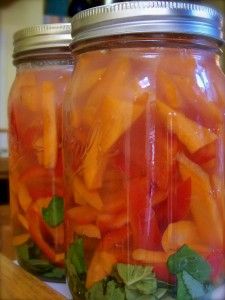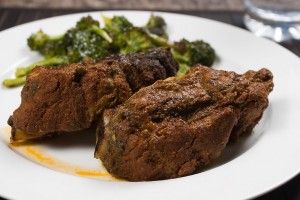
© Unknown
I hear and read about lots of people making kale smoothies, consuming raw nuts, and munching salads consisting of raw broccoli. So, I decided to take a look at some research to see what the nutritional costs were to eating raw foods. The truth is, it's better for your body to consume primarily cooked or lacto-fermented vegetables. Breaking down the cellular structure of vegetables through these methods grately increases the digestibility and nutrient absorption of nutrients in vegetables. Much of the research I've found suggests several reasons why cooking might increase the energy available from meat. These include increasing food intake through positive effects on palatability related to texture and flavor, rendering proteins more digestible through denaturation, lowering the cost of digestion through food softening, and reducing immune upregulation by eliminating foodborne pathogens. Given that textural changes are at least partially responsible for the proposed positive effects of cooking on intake, digestibility, and the cost of digestion, non-thermal processing methods that manipulate texture, such as pounding, may likewise be effective in improving the net energy value of meat.
Foods have been heat-treated for many centuries, since our ancestors learned, by trial and error, to master fire for cooking purposes approx. 700,000 years ago, to modify the taste and preserve nutritional properties of foods. The invention and continuous development of food treatment has had a substantial, if not major impact on the intellectual, societal and economic development of mankind. The health benefits of fermentation have been known for centuries. In 76 A.D., the Roman historian Plinio advocated the use of fermented milks for treating gastrointestinal infections.
Cooking destroys toxins.The first and most important beneficial effect of food processing is that it destroys unwanted compounds and micro-organisms. Pathogenic bacteria are killed when exposed to heat. Cooking also inactivates anti-nutritional factors such as protease inhibitors and other natural toxins. The second effect is enhanced digestibility of food and bioavailability of nutrients. For example, gelatinization of starch makes possible its hydrolysis by amylase enzymes. Destruction of cell walls in vegetables improves the bioavailability of compounds such as carotenoids and polyphenols. Nuts and seeds contain many anti-nutrients in their raw state.
Soaking your nuts overnight will increase the bioavailability of the nutrients in nuts and seeds.
Crucifers (like kale) should always be cooked.Certain foods are associated with disrupted thyroid hormone production. Foods belonging to the cruciferous family are called "crucifers," and include broccoli, kale, cauliflower, Brussels sprouts, cabbage, mustard, kohlrabi, and turnips. These foods appear to reduce thyroid function by blocking thyroid peroxidase, and also by disrupting messages that are sent across the membranes of thyroid cells. Cooking these vegetables greatly reduces these negative effects.
Eating raw food has a cost.Cooking also appears to have a positive effect on net energy in the body. Humans on vegetarian diets exhibit higher reproductive performance when eating cooked food than raw food. Evidence of low energy intake in women eating predominantly rawfood is supported by their having higher rates of amenorrhea or menstrual irregularities than those eating cooked food. In one study, it was found that menstruation was absent in 23% of females of childbearing age who ate at least 70% of their food raw and in 50% of women reporting a 100% raw diet. Although these women were primarily vegetarian, the addition of raw meat to the diet did not change the odds of ovarian suppression. The researchers concluded that women suffered because of their relatively low net energy gain as a consequence of eating their food raw. A nutritional analysis suggested that in traditional communities, a diet of raw wild foods would render survival and reproduction difficult.

© Unknown
Fermentation is a non-thermal process that produces chemical changes by enzymes produced from bacteria, microorganisms or yeasts and is one of the oldest known food preservation techniques. During fermentation, the carbohydrate energy source in food, such as lactose in milk is converted to lactic acid. The same happens when pickles are produced from cucumbers. Yeasts convert glucose to ethanol and carbon dioxide. Many health-producing secondary metabolites are produced through fermentation, especially B vitamins and bioactive peptides which can be antimicrobial and immune-stimulatory. In the early 1900s it was realized that bifidobacteria may be effective in preventing infection in infants and the consumption of fermented milks were seen to reverse putrefactive effects of the gut micro flora, leading to the development of the probiotic concept. Probiotics are now used in the treatment of infections and used to promote a healthy immune system. Consuming fermented foods will improve the presence of healthy bacteria in the gut.
Pounding, curing and cooking meat is beneficial.When considering meat, there seems to be some evidence that processing meat either by pounding, drying, curing or cooking is beneficial. Pounding meat and making it soft seems to reduce the cost of digestion, partly because it pass more quickly through the gut. The collagen surrounding each fascicle of muscle fibers generally remains too tough for mastication until heated to 60 - 70 C, when collagen begins to be hydrolysed into gelatin, a soluble protein. Although the muscle fibers themselves remain tough, eat cooked beyond this temperature leads to gelatinisation of the collagen, which separates leads the muscle fibers and the gelatin.
Improved texture of meat makes it easier to chew, and easier for our bodies to break down. Also when the fats are heated to oil from a fat, it's easier for our bile to emulsify and ultimately leads to faster absorption. In studies, humans and chimps prefer the taste of cooked meat, leading to us eating more of it. Consumption of more protein meant larger brains and bigger muscles as we evolved.
Higher fat meats can lead to better energy balance.It is important to note that eating cooked very lean meats has a nutritional cost. Archaeological evidence suggests that fat derived from bone marrow may have been preferred over muscle tissue as a source of energy and nutrients among early humans. Diets deriving more than 50% of calories from lean protein can lead to negative energy balance, so-called ''rabbit starvation,'' due to the high metabolic costs of protein digestion.

© Unknown
Cooking kills foodborne bacteria, including strains associated with raw meat products such as
Escherichia coli, Salmonella, Campylobacter, Staphylococcus, and
Listeria. The potential energy savings due to reduced immune maintenance and upregulation could be sizeable. Raw wild meat is possibly less pathogen-bearing on average than raw meat that has been raised and processed for mass-market consumption. When meat is processed at the slaughterhouse,
ecoli and other pathogens from the intestines can invade the ground meat. This is why most outbreaks involve burgers and other forms of ground meat but is not usually associated with steaks. These pathogens do not enter the inside of the muscle tissue (steaks). When eating industrially raised red meat, I suggest cooking the burgers well. Slow cooking meat appears to be one of the best methods to prepare meat for optimal digestibility.
Lightly cooked fish is healthier than raw or fried.In the case of fish, it appears that lightly cooked is optimal. In one study where edible portions of fresh fish were used raw, fried, cooked and undercooked, the researchers concluded that the breakdown of fish proteins were all fairly complete, but general digestibility was greatest with underdone fish as compared to raw, fully cooked or fried fish.
In summary, I strongly suggest cooking vegetables, consuming lacto-fermented vegetables, and other fermented foods. If you like to eat raw meat, make sure it is from a very clean source and it's safer to stick to muscle and organs which are less likely to be contaminated with pathogens. If you are out at a restaurant and want a standard industrially-raised beef burger, order it cooked well. Focus on slow cooking processes and using primarily grass-fed and wild meats, where the animals are much less likely to be sick (and get you sick). These meats will also have a much better ratio of omega-3 to omega-6 fats, thereby keeping inflammation down. Sashimi and other raw fish from trusted sources are ok, but lightly cooked fish seems to be optimal as far as protein digestion.
References:Barham, P., 2001.
The Science of Cooking. Springer, Berlin.
Blumenschine, R.J., Hominid carnivory and foraging strategies, and the socioeconomic function of early archaeological sites.
Phil. Trans. R. Soc. Lond., 1991
Series B 334, 211 - 221.
Blumenschine, R.J., Madrigal, T.C., Variability in long bone marrow yields of East African ungulates and its zooarchaeological implications.
J. Archaeol. Sci. 1993
20, 555 - 587.
Carmody, Rachel N.; Wrangham, Richard W., The energetic significance of cooking.
Journal of Human Evolution 2009,
57, 379 - 391.
Evenepoel, P., Geypens, B., Luypaerts, A., Hiele, M., Rutgeerts, P., Digestibility of cooked and raw egg protein in humans as assessed by stable isotope techniques.
J. Nutr. 1998,
128, 1716 - 1722.
Halton, T.L., Hu, F.B., The effects of high protein diets on thermogenesis, satiety and weight loss: a critical review.
J.Am. Coll. Nutr. 2004,
23, 373 - 385.
Koebnick, C., Strassner, C., Hoffmann, I., Leitzmann, C., Consequences of a long-term raw food diet on body weight and menstruation: results of a questionnaire survey.
Ann. Nutr. Metab. 1999,
43, 69 - 79.
Laden, G., in: Eisenbrand, G., Engel, K.-H., Grunow, W., Hartwig, A., Knorr, D., Knudsen, I., Schlatter, J., Schreier, Thermal Processing of Food: Potential Health Benefits and Risks.
Deutsche Forschungsgemeinschaft (DFG)-Symposium, 2006, Senate Commission on Food Safety (SKLM).
Oka, K., Sakuarae, A., Fujise, T., Yoshimatsu, H., Sakata, T., Nakata, M., Food texture differences affect energy metabolism in rats.
J. Dent. Res. 2003,
82, 491 - 494.
Saha, K.C. The Effect of boiling and frying on the enzymic hydrolysis of fish protein.
Journal of the Indian Chemical Society. 1940,
17, 259-63.
Speth, J.A., Spielmann, K.A., Energy source, protein metabolism,and huntergatherer subsistence strategies.
J. Anthropol. Archaeol. 1983, 2, 1 - 31.
Van Boekel, Martinus; Fogliano, Vincenzo; Pellegrini, Nicoletta; Stanton, Catherine; Scholz, Gabriele; Lalljie, Sam; Somoza, Veronika; Knorr, Dietrich; Rao Jasti, Pratima; Eisenbrand, Gerard, A review on the beneficial aspects of food processing.
Mol. Nutr. Food Res. >2010,
54, 1215 - 1247.
Wrangham, R., 2009.
Catching Fire: How Cooking Made Us Human. Basic Books, New York, NY.
I ever had in my life was when my mother threw big parties with 30-40 guests and made all the cooking herself. She started without knowing anything about cooking. I wanted to learn during a period when I was unemployed but I guess my in-born lazyness threw me over making executive decisions. So much for food.
I don't think I'll eat ever that well in my life. Besides good times or moments don't last for long. That's why they are so precious. Neither they can be repeated.